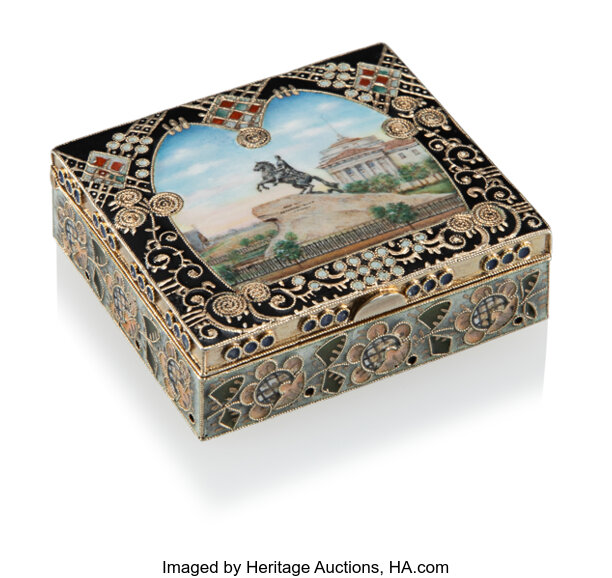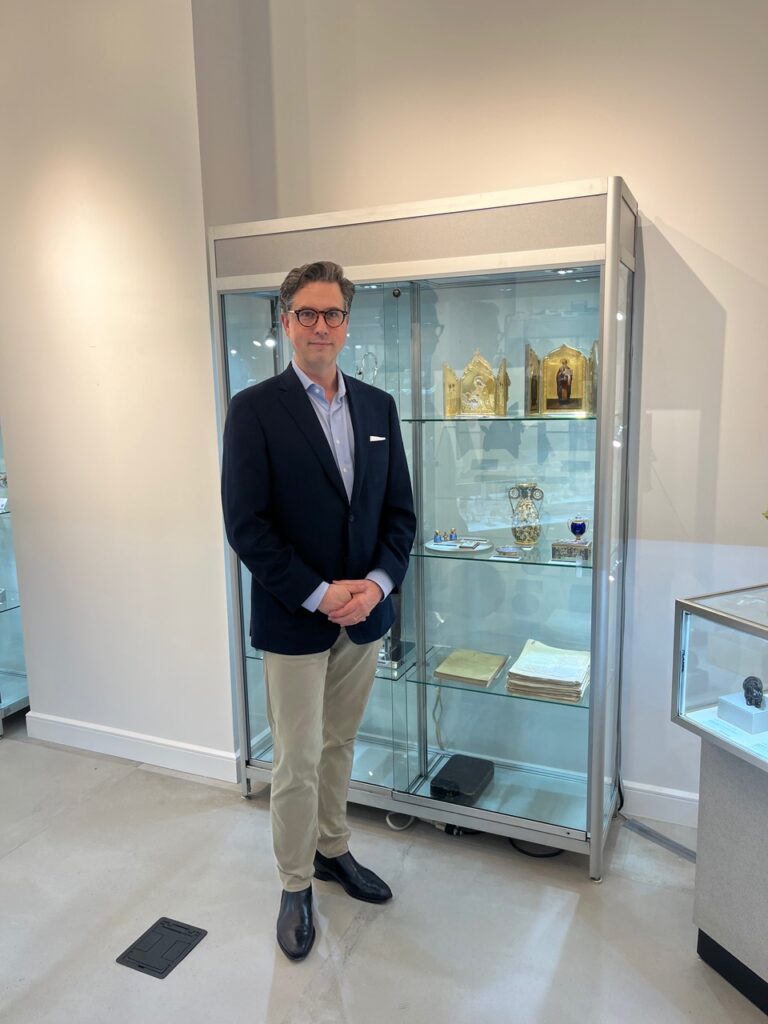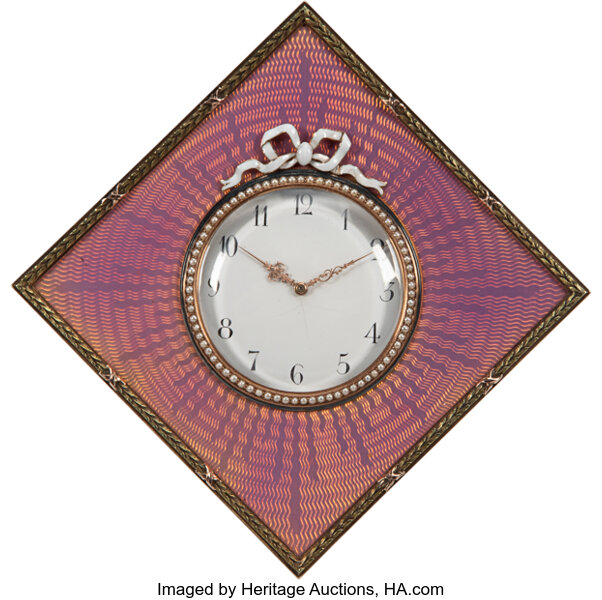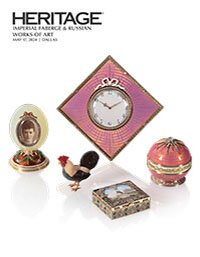
By Judy Carmack Bross

An Imperial Fabergé Cloisonné and En Plein Enameled box belonging originally to Empress Maria Feodorovna.
“On my first day at Heritage Auctions, a colleague showed me a photograph of five extraordinary works by Fabergé and asked, ‘What do you think?’ I replied, ‘I think we need to get on a plane’.”—Nick Nicholson, Heritage Auctions’ Senior Specialist in Russian Works of Art, the recognized expert in the works of famed court jeweler Carl Fabergé, about the call he received soon after starting his current job.

Nick Nicholson
It was the message that everyone in the auction world dreams of a hint of treasures bought from the Russian royal family in 1949 when a Prince arrived in America. These objects were last seen publicly in 1996 as part of the bi-coastal landmark museum exhibition “Fabergé in America.” A friend of a friend had reached out to Heritage about a possible sale, and the results of Nicholson’s trip appear in the May 17 Auction at Heritage.
“The universe was definitely on our side,” Nicholson said. “It is very exciting and unusual to bring so many pieces of Fabergé that are completely fresh to the market to auction. The works are of incomparable quality as well as rarity.”

Empress Maria Feodorovna’s Imperial Fabergé Two-Color Gold-Mounted Translucent Pink Guilloché Enameled Gilt Silver Bell Push
Dowager Empress Maria Feodorovna’s opalescent enameled silver bell push is among the Imperial pieces offered. Purchased by Emperor Nicholas II and Empress Alexandra Feodorovna and given to the Dowager Empress Maria, it was passed down to her daughtr Grand Duchess Xenia Alexandrovna to her son Prince Vasili Alexandrovich who it sold it April 1949 to a California collector. The family of the anonymous seller, who contacted Heritage, are descendants of the purchaser.
When the members of the Imperial family fled to Crimea they took personal pieces with them. The Dowager Empress Maria, sister of Queen Alexandra, and the Grand Duchess Xenia were rescued at Yalta by the captain of the HMS Marlborough and sailed away in 1919. Some of the pieces they carried went to the royal collection of George V in England, a cousin and a close friend of Tsar Nicholas II. They looked almost like twins. “Some of the pieces went to Denmark as well as to America. The Romanoffs found employment in California and moved there in the 1930s and 1940s,” Nicholson said. “These objects definitely reflect the tastes of the Imperial family before the revolution.”
“The enameled bell push, is, in all ways but color, identical to one in lilac, formerly in the collection of the Dowager Empress’s bother, King George of Greece. They even bear the same scratched inventory number,” Nicholson said. “Everything made by the firm was personally checked by Fabergé, who insisted on perfection.”

From the collection of Empress Maria Feodorovna: An Imperial Fabergé Diamond Set and Enameled Gold-Mounted Bowenite Egg-Shaped Frame.
In 1842, Gustav Fabergé founded his storied firm in St. Petersburg, with the most prized and beautiful work, called “Imperial Fabergé” applying only to those pieces created for the Russian Emperors and their families, and those purchased by them which were to become fabulous gifts from the royal family to others.
We talked with Nick Nicholson about Imperial Fabergé and learned that it is so much more than jewel-encrusted eggs for which the firm is so recognized. “Fabergé was an artist in so many ways and brought fresh life to silver and jewelry as well. He was a fierce and formidable competitor of Cartier, Chaumet, Tiffany, and Boucheron.”

Once in the collection of the Grand Duchess Xenia Alexandrovna: An Imperial Fabergé Two-Color Gold and Opalescent Pink Guilloché Enameled Diamond-Shaped Clock.
This clock entered Fabergé’s stock in 1894 and may have been purchased by or gifted to Grand Duchess Xenia on the event of her marriage in August of that year. The clock and other Romanoff family treasures that traveled from Russia were given to Prince Vasili for safekeeping before 1947.
Nicholson, whose mother was born in Lake Forest and whose grandparents both attended the University of Chicago, recently spoke in Chicago at Heritage about “Fabergé in Exile.”

Nicholson has a long history with Russian works of art, and has offered works from the collections of Landsell Christie, Jane Englehardt, Rudolf Nureyev, Frank Sinatra, and Malcolm Forbes at auction. Nick’s Russian curatorial experience includes exhibitions at the Brooklyn Museum, the Corcoran Gallery of Art, the Museum of Fine Arts, Houston, the Icon Museum & Study Center, the Russian History Museum, and the Tsarskoye Selo Museum-Preserve among others. He began his auction career at Christie’s as Specialist in Russian works of Art, and later was Division Head of Furniture and Decorative Arts at Freeman’s. As Heritage’s Senior Specialist in Russian Works of Art, Nicholson oversees Russian painting, sculpture, silver, enamels, icons, porcelain, historical and Imperial ephemera, and works by the famed court jeweler Carl Fabergé, in which he is a recognized expert.
“Although one needs specialist knowledge and the passion for the material, much of this business is simply fate and being in the right place at the right time. We won’t see a collection of Imperial Fabergé like this again any time soon. Not every call will be a call like that.”
Fabergé’s animals have been collector favorites for more than a century.

An Imperial Fabergé hardstone cockerel with gold feet, that belonged to the Dowager Empress, is one of a surviving number of composite carved hardstone objects that became popular when incomparable stone carvers arrived from the Ural Mountains: this from the workshops of Henrik Wigström.
Along with more than 70 pieces with Imperial provenance there are 100 other Russian pieces from the collection of Ruth Nelkin, a New York collector and connoisseur of fine and antique jewelry and accessories.
For more information about the May 17th sale, visit: ha.com/8150







